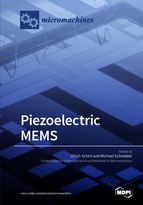Piezoelectric MEMS
A special issue of Micromachines (ISSN 2072-666X).
Deadline for manuscript submissions: closed (30 June 2017) | Viewed by 74634
Special Issue Editors
Interests: MEMS (e.g. sensors, actuators); PiezoMEMS; SiCMEMS; MEMS materials (e.g. SiC, AlN, ScAlN, PVDF); material characterization; micro-and nanomachining technologies; NEMS (e.g. sensors, actuators); packaging aspects
Special Issue Information
Dear Colleagues,
Electromechanical transducers based on piezoelectric layers and thin films are continuously finding their way into micro-electromechanical systems (MEMS). Piezoelectric transducers feature a linear voltage response, no snap-in behavior and can provide both attractive and repulsive forces. This removes inherent physical limitations present in the commonly used electrostatic transducer approach while maintaining beneficial properties such as low-power operation. In order to exploit the full potential of piezoelectric MEMS, interdisciplinary research efforts range from investigations of advanced piezoelectric materials over the design of novel piezoelectric MEMS sensor and actuator devices, to the integration of PiezoMEMS devices into full low-power systems.
In this Special Issue, the current state of this exciting research field will be presented, covering a wide range of topics including, but not limited to:
Experimental and theoretical research on piezoelectric materials such as AlN, ScAlN, ZnO or PZT, PVDF with a strong focus on the application in MEMS devices.
Deposition and synthesis techniques for piezoelectric materials enabling integration of those materials into MEMS fabrication processes.
Modelling and simulation of piezoelectric MEMS devices and systems.
Piezoelectric MEMS resonators for measuring physical quantities such as mass, acceleration, yaw rate, pressure and viscosity or density of liquids.
Optical MEMS devices, such as scanning micro mirror devices and optical switches, based on piezoelectric MEMS.
Acoustic devices, such as SAW, BAW or FBARs and acoustic transducers, based on piezoelectric MEMS such as microphones or loudspeakers.
Piezoelectric energy harvesting devices.
Specific packaging aspects of piezoelectric devices and systems.
Low and zero power systems, featuring low-power sensors combined with energy harvesting devices, at least one of which is based on piezoelectric MEMS.
Prof. Dr. Ulrich Schmid
Dr. Michael Schneider
Guest Editors
Manuscript Submission Information
Manuscripts should be submitted online at www.mdpi.com by registering and logging in to this website. Once you are registered, click here to go to the submission form. Manuscripts can be submitted until the deadline. All submissions that pass pre-check are peer-reviewed. Accepted papers will be published continuously in the journal (as soon as accepted) and will be listed together on the special issue website. Research articles, review articles as well as short communications are invited. For planned papers, a title and short abstract (about 100 words) can be sent to the Editorial Office for announcement on this website.
Submitted manuscripts should not have been published previously, nor be under consideration for publication elsewhere (except conference proceedings papers). All manuscripts are thoroughly refereed through a single-blind peer-review process. A guide for authors and other relevant information for submission of manuscripts is available on the Instructions for Authors page. Micromachines is an international peer-reviewed open access monthly journal published by MDPI.
Please visit the Instructions for Authors page before submitting a manuscript. The Article Processing Charge (APC) for publication in this open access journal is 2600 CHF (Swiss Francs). Submitted papers should be well formatted and use good English. Authors may use MDPI's English editing service prior to publication or during author revisions.
Keywords
Piezoelectric materials
Simulation and modeling of piezoelectric MEMS
Piezoelectric MEMS resonators
Acoustic MEMS devices
Surface acoustic wave devices
Piezoelectric energy harvesting
Packaging of piezoelectric MEMS
Smart electronics for piezoelectric devices and systems








